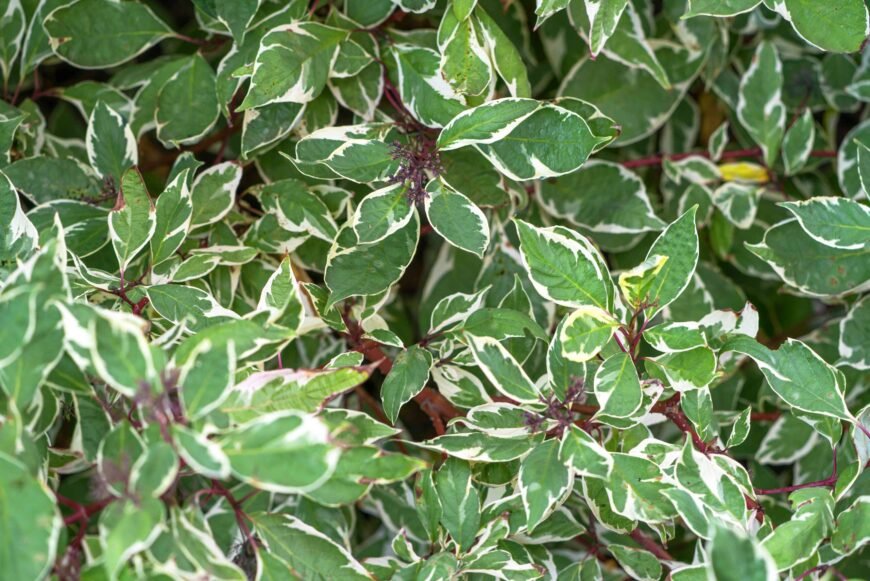| Common Name | Ivory Halo dogwood |
| Botanical Name | Cornus alba ‘Bailhalo’ |
| Family | Cornaceae |
| Plant Type | Deciduous Shrub |
| Mature Size | 4-6 ft. tall, 4-6 ft. wide |
| Sun Exposure | Full sun to part shade |
| Soil Type | Organically rich, moist, well-drained soil |
| Soil pH | Acidic to neutral soil |
| Bloom Time | May to June |
| Hardiness Zones | 3 to 7 (USDA) |
| Native Area | None (Cultivar) |
Ivory Halo Dogwood Care
The Ivory Halo dogwood is extremely easy to care for with few maintenance requirements and minimal problems as long as these main care requirements are followed:
- Plant Ivory Halo dogwood in an area with organically rich soil.
- Water to keep the soil consistently moist.
- Ensure it receives either full sun or partial shade.
- Avoid climates where the Ivory Halo will be exposed to excessive heat.
Light
Full sun may prove too much for the shrub and scorch the leaves in areas that experience excessive heat, so planting in partial shade is preferable. Providing your Ivory Halo dogwood with sufficient light will ensure that it produces the beautiful foliage that gives it spring and summer interest.
Soil
While the Ivory Halo is somewhat adaptable regarding soil, it will perform much better if planted in organically rich, consistently moist, and well-draining soil with a slightly acidic to neutral pH. Testing the soil’s pH before planting is recommended so you can add soil amendments before planting rather than after.
Water
Ivory Halo dogwoods need consistently moist soil to thrive. They prefer well-draining soil but will tolerate occasional standing water for brief periods. Maintaining the shrub’s moisture is especially important in the warmer summer months or in areas that experience higher temperatures.
Watering your Ivory Halo is even more important when it is first planted. Encouraging the plant to establish a healthy and strong root structure for the first two growing seasons is vital. Giving the shrub a good soaking that saturates the soil to 2 to 3 inches deep weekly will guarantee your Ivory Halo dogwood is properly watered.
Temperature and Humidity
Temperature is the most important of all conditions that can affect an Ivory Halo dogwood. If a shrub is suffering, it is most likely related to temperature or lack of moisture due to temperature.
To give your Ivory Halo the best chance at success, even in the extremities of its hospitable zone, you may need to provide a more conducive and attractive microclimate to the cultivar. You can do this by planting it in partial shade; in a rain garden; in an area that receives morning sun instead of the afternoon sun; or in a location with plentiful cool breezes.
For the best chance of success, always plant the Ivory Halo dogwood in its recommended USDA zones of 3 through 7.
Fertilizer
Applying a supplemental fertilizer is not necessary to help this particular cultivar thrive. If you plan to use a fertilizer, using one with a higher nitrogen percentage in its NPK formulation is your best bet to induce foliage and stem growth. Remember, the Ivory Halo dogwood’s main attribute is not its blooms, so adding a fertilizer that bolsters flowering will not help highlight this cultivar’s aesthetic values.
Pruning Ivory Halo Dogwood
Pruning an Ivory halo dogwood is not necessary unless you want to encourage new growth. The stems of the shrub are the main attraction of the Ivory Halo, so it’s common to trim a quarter to a third of old growth every spring to encourage new growth. For those looking to avoid yearly pruning, you can cut the shrub to a height of around 6 inches every three years to completely renew your Ivory Halo dogwood.
Common Pests & Plant Diseases
Most pests and plant diseases associated with the Ivory Halo dogwood are not serious enough to kill the shrub and are considered nuisances at worst.
The most common insects are scale and leaf miners, which can usually be removed with pesticides and pruning infected plant material.
Common diseases that occur are canker, leaf spot, and blight. These diseases are usually not serious, but they are often signs that there are other underlying issues making it susceptible to these diseases. Most often this can be attributed to extreme heat or underwatering.
If planted in the right conditions and provided with ample moisture, the Ivory Halo dogwood is a relatively problem and maintenance light plant. If issues occur, it is most often due to temperature or lack of water. The issues can appear as canker or occasionally but rarely scorch.
-
-
How fast do Ivory Halo dogwoods grow? Ivory Halo dogwoods are considered fast growing and will grow 6 to 12 inches per year in the right conditions.
-
-
-
Why is my Ivory Halo dogwood dying? An Ivory Halo dogwood can be dying for numerous reasons, but most commonly it’s high temperatures, too dry conditions, or soil too shallow to allow strong roots to develop.
-
-
-
Do Ivory Halo dogwood plants like sun or shade? Ivory halo dogwoods prefer full sun to part shade. In warmer climates, err towards planting in a location that receives partial shade.
-
